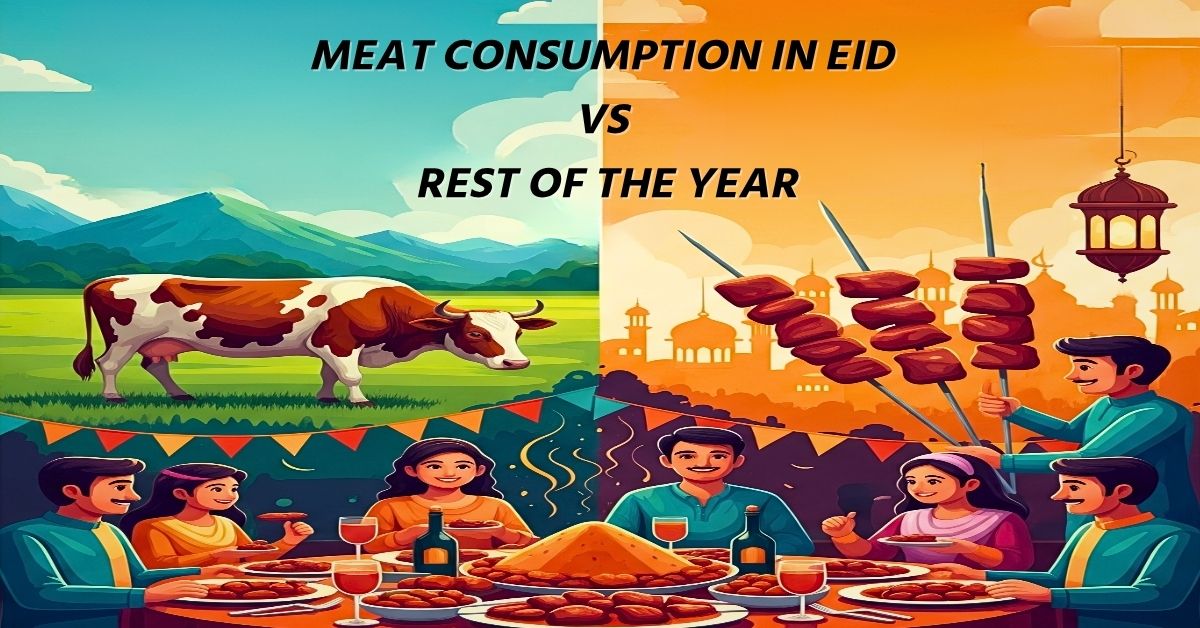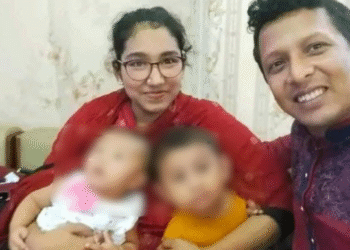Introduction
Every year, Eid ul Adha transforms Bangladesh’s food landscape. This sacred festival brings with it a tidal wave of meat changing not only what’s on the dinner table, but how people interact with food, share resources, and experience economic activity. The contrast in meat consumption between Eid ul Adha and the rest of the year is staggering, shaped by faith, culture, affordability, and infrastructure.
This article explores how meat consumption surges during Eid ul Adha and how it compares with patterns during the rest of the year through the lenses of religion, economy, nutrition, social equity, and market logistics.
Spiritual Reflection: Reviving the Spirit of Submission
At its core, Qurbani is not just about the sacrifice of animals but about the spirit of submission and devotion to Allah. When Prophet Ibrahim (A.S) prepared to sacrifice his son Ismail (A.S), it was an ultimate act of surrender to divine command. Allah, in His infinite mercy, replaced the son with a ram setting the foundation for a ritual that would echo through generations.
Every drop of blood spilled in Qurbani is not just an offering of flesh, but a symbol of letting go of ego, pride, and worldly attachment. In the Qur’an (Surah Al-Hajj 22:37), Allah says:
“Their meat will not reach Allah, nor will their blood, but what reaches Him is piety from you.” This powerful reminder steers believers toward inner purification and solidarity with those in need.
Animal Sacrifice in Numbers
According to Bangladesh’s Department of Livestock Services:
-
Over 1 crore (10 million) animals are sacrificed during Eid ul Adha every year.
-
Cattle (cows, buffalo): Around 4.5–5 million.
-
Goats and sheep: Around 5–6 million.
-
Camels (very rare in Bangladesh): A small symbolic number.
Estimated Meat Yield:
-
A cow yields around 100–120 kg of meat.
-
A goat or sheep yields 10–20 kg on average.
Given this, over 400,000 metric tons of meat flood into homes during Eid ul Adha.
To put this into perspective:
-
That’s more than half of the country’s average annual beef consumption packed into just a few days.
-
It surpasses the monthly meat consumption of many countries with larger populations, like Indonesia or Nigeria.
Social Equity: Sharing the Blessing
Qurbani also serves as a profound instrument of social justice. In Bangladesh, where a significant portion of the population lives under the poverty line, the distribution of Qurbani meat provides a rare opportunity for families to enjoy protein-rich meals something that remains unaffordable throughout the rest of the year.
The meat is ideally divided into three parts:
-
One-third for the family,
-
One-third for relatives and friends,
-
One-third for the poor and needy.
This act reinforces community bonding, compassion, and empathy, especially in densely populated urban slums and rural communities where daily survival is a struggle. For many underprivileged families, Qurbani meat is the only time in the year they consume beef or mutton.
Cultural Traditions and Eating Patterns During Eid
During Eid, the role of meat in meals takes center stage like no other time of the year. The celebration revolves around rich, meat-based dishes that bring families and communities together in joyous feasting.
Day 1 (Eid Day):
The day typically begins with a special breakfast, where liver fry (kolija bhuna) is a popular choice, symbolizing the start of the festivities. For lunch, hearty dishes such as beef curry or rezala—a fragrant Mughlai-style meat curry—are served. Dinner often features elaborate preparations like beef tehari or biryani, both celebrated for their rich flavors and aromatic spices.
Days 2 to 5:
The following days are marked by continuous social gatherings. Friends and relatives visit each other’s homes, and meat remains the star of every meal. Barbecues, beef roasts, and other grilled delicacies are common as people savor the spirit of Eid with lavish hospitality and shared meals.
Storage and Leftovers:
In urban areas, the widespread availability of freezers allows families to store excess meat for weeks, preserving it safely for later consumption. However, in rural regions where refrigeration is less accessible, meat is often dried, smoked, or quickly distributed among family, friends, and neighbors to prevent spoilage.
Many NGOs play a vital role during this time by collecting extra Qurbani meat to ensure it reaches orphans and vulnerable groups, extending the blessings of Eid beyond immediate communities and fostering a spirit of charity and care.
Meat Consumption Patterns Throughout the Year
While Eid brings a period of meat abundance and celebration, the rest of the year reflects the economic realities and inequalities that shape dietary habits across Bangladesh.
Weekly Consumption Averages:
-
Urban middle-class families: Typically consume meat 2 to 3 times a week, with chicken being the most common and affordable choice.
-
Low-income families (urban slums and rural areas): Meat consumption is much rarer, averaging once every 10 to 15 days, often reserved for special occasions or festivals.
-
High-income households: Enjoy a diverse range of meats several times a week, including beef, chicken, mutton, and seafood, reflecting greater purchasing power and varied culinary preferences.
Types of Meat Eaten Annually:
-
Chicken: The most affordable and widely consumed meat across all socioeconomic groups, available throughout the year.
-
Beef: Generally reserved for festivals, celebrations, or special family gatherings due to its higher price.
-
Mutton/Goat: More expensive than beef and considered a delicacy, often featured in special dishes during festive times.
-
Fish: Despite meat’s cultural prominence, fish remains the most consumed animal protein in Bangladesh year-round, thanks to its relative affordability and availability.
Nutritional Impact
Eid ul Adha temporarily boosts the nutritional intake of millions of Bangladeshis. During this period, protein consumption rises sharply, providing essential nutrients specially for low-income families and growing children who might otherwise have limited access to animal protein.
However, this surge in meat consumption can also present health challenges:
-
Overeating red meat during the festivities may cause indigestion, elevate cholesterol levels, and put strain on the heart.
-
Individuals with diabetes, hypertension, or other chronic conditions are often advised to balance their meals with plenty of vegetables and fiber to mitigate these risks.
-
The long-term nutritional benefits are limited if meat consumption remains low or sporadic throughout the rest of the year, reducing sustained improvements in diet quality.
Qurbani: A Driving Force of the Seasonal Economy
In Bangladesh’s seasonal economy, Eid ul Adha is more than just a holy holiday. As the festival approaches, the nation shifts into high gear. Rural fields buzz with preparation, highways swell with livestock-laden trucks, and urban centers transform into makeshift marketplaces. Behind the scenes, millions of Bangladeshis from farmers to freight workers depend on this moment to earn a substantial portion of their annual income.
- Cattle Market Surge
In the weeks leading up to Eid, temporary cattle markets (haat) spring up across the country like clockwork. Gabtoli in Dhaka the largest of its kind becomes a trading hub, hosting tens of thousands of animals and attracting buyers from all income levels. Similar scenes unfold in Rajshahi, Chattogram, Khulna, Sylhet, and Barishal. Each market is a complex ecosystem: not only animals and buyers, but also feed vendors, food stalls, security personnel, and money handlers create a vibrant, albeit chaotic, micro-economy.
These haats often generate hundreds of crores in transactions in just a few days, temporarily boosting liquidity and cash flow in both rural and urban pockets.
- Rural Boost
The backbone of this surge lies in rural Bangladesh. In districts such as Kurigram, Dinajpur, Pabna, and Sirajganj, smallholder farmers raise livestock throughout the year, hoping for favorable prices during Eid. Many of these families treat livestock rearing as a form of informal savings, feeding and caring for their animals with devotion, in hopes of securing fair returns when the season comes.
For these farmers, Qurbani is more than tradition it is survival. The proceeds from a single cow or goat sale often cover school fees, medical bills, or reinvestment into their small agricultural businesses. The ripple effect strengthens rural resilience and uplifts entire villages.
Urban Commerce
In urban areas, the Qurbani season triggers a burst of short-term employment and small business activity. Butchers, animal transporters, rope makers, knife sharpeners, plastic sheet vendors, and livestock caretakers suddenly find high demand for their services.
Even seemingly minor roles like sack sellers for meat distribution or laborers to clean sacrifice sites turn into income-generating opportunities. This economic flurry also energizes adjacent sectors such as:
-
Transportation: Trucks, pickups, and boats (in haor regions) are booked weeks in advance.
-
Veterinary Services: Health check-ups and vaccinations increase as animal health certification becomes mandatory in many city haats.
-
Digital Platforms: Online Qurbani startups hire photographers, delivery drivers, and customer service teams, offering a new wave of tech-driven seasonal jobs.
Economic Impact: A Sector That Feeds the Nation
According to the Department of Livestock Services, the livestock sector contributes around 1.47% to Bangladesh’s GDP, with direct employment to over 20 million people and indirect engagement of many more. During the Qurbani period, this contribution spikes significantly.
In 2024, over 10.5 million animals were sacrificed during Eid ul Adha. The estimated market size of this short-term animal trade exceeded Tk 50,000 crore (approx. USD 4.5 billion) a monumental figure for a single event spanning just a few weeks.
This seasonal stimulus brings rare economic balance it redistributes wealth from urban consumers to rural producers and temporary workers, enhancing cash circulation, boosting retail, and reinforcing Bangladesh’s informal economic web.
Meat Industry and Cold Chain Logistics
Economic Boom During Eid:
Eid ul Adha significantly boosts multiple sectors connected to the meat industry:
-
Livestock farmers earn a substantial portion of their annual income during this period, relying heavily on Qurbani demand.
-
Butchers and transporters experience a surge in business, working overtime to meet the increased need for fresh meat.
-
E-commerce platforms offering “online Qurbani” services report double or even triple their regular order volumes as consumers seek convenient ways to participate.
-
The leather industry also gears up during Eid, preparing to process the large quantities of animal skins collected, which supports downstream manufacturing and export activities.
Cold Chain Challenges:
Despite these economic gains, Bangladesh’s cold chain infrastructure faces significant hurdles:
-
Only about 10–15% of meat is properly preserved after slaughter, leading to substantial spoilage risks.
-
Many rural areas lack adequate freezing and refrigeration capacity, forcing families to consume or distribute meat quickly to avoid waste.
-
The spike in demand during Eid places additional stress on urban electricity supplies and logistics networks, complicating storage and distribution.
-
Effective cold chain management, waste disposal, and hygienic slaughterhouse practices remain critical policy challenges, specially in major cities like Dhaka, Chattogram, and Khulna.
Addressing these challenges is essential for improving food safety, reducing losses, and supporting the growing meat market in Bangladesh year-round.
Urban vs Rural: How Eid Feels Different
Urban Areas:
In cities, preparations for Eid start well in advance. Many people buy animals days before the sacrifice and keep them in garages or on rooftops, adapting limited space creatively. Butchers are in extremely high demand, with some booked weeks ahead. Freezers in homes and shops overflow with marinated meat and biryani supplies, ready for the feast.
Rural Areas:
In contrast, rural communities often perform sacrifices in open spaces, supported by neighbors and extended family. Meat is shared widely, sometimes with entire villages, and many meals are cooked communally as part of the celebration. Due to limited refrigeration, meat is consumed quickly or preserved by drying and smoking.
Despite these logistical and environmental differences, the spirit of sharing, generosity, and faith remains strong and unites communities across Bangladesh during Eid.
Global Comparisons
Bangladesh is not alone in this pattern.
Pakistan:
-
Similar meat spike during Eid.
-
8–10 million animals sacrificed.
-
Freezer vans and mobile butchers rise during Eid week.
India (Muslim Population):
-
Despite legal restrictions in some states, millions of animals are sacrificed by Muslims.
-
Urban Muslim communities rely on delivery-based Qurbani services.
Middle East (Saudi Arabia, UAE):
-
Many opt to donate Qurbani abroad via charity organizations.
-
Cold storage and meat processing are far more advanced.
In contrast to these countries, Bangladesh faces the challenge of managing a massive, decentralized, and community-driven system without centralized meat processing facilities.
Post-Eid Meat Surplus: A Policy Window
The period following Eid ul Adha presents a unique opportunity for policymakers to address several important issues:
-
Monitor dietary changes and assess the impact of increased protein intake on vulnerable groups, specially children and women.
-
Pilot innovative meat preservation methods, such as solar dryers and cooperative freezer systems, to extend shelf life and reduce spoilage.
-
Minimize waste by improving the handling, hygiene, and disposal of offal and other meat by-products.
-
Boost rural incomes by strengthening market linkages that connect livestock producers with urban buyers throughout the year, helping to stabilize demand beyond the festival season.
Capitalizing on this window could help transform short-term gains into sustainable improvements for Bangladesh’s meat sector and nutritional outcomes.
Role of Technology and Innovation
-
Mobile Apps and Digital Marketplaces: Recently, online platforms have revolutionized the Qurbani market by connecting rural farmers directly with urban consumers, improving transparency and pricing.
-
Cold Chain Innovations: Solar-powered refrigeration and community freezer hubs are emerging to tackle storage challenges in off-grid rural areas, aiming to reduce meat spoilage after Eid.
-
Animal Health Monitoring: Digital tracking and veterinary apps help ensure healthier livestock, reducing disease risks that can affect meat quality during peak demand.
-
Blockchain and Traceability: Some pilot programs are exploring blockchain to ensure halal compliance, animal welfare, and meat authenticity, boosting consumer confidence.
Economic Diversification Around Eid Meat Demand
-
New Business Opportunities: Qurbani stimulates allied sectors such as feed production, veterinary pharmaceuticals, packaging materials, and transportation services.
-
Seasonal Employment: Temporary jobs during Eid extend beyond butchery — including sanitation workers, security personnel, and event organizers — providing income to marginalized groups.
-
Microfinance and Credit: Many livestock farmers rely on seasonal credit or microloans to finance animal rearing. Eid’s income spike allows them to repay debts and improve financial stability.
-
Women’s Participation: In some regions, women engage in meat preparation, marketing, or cooperative meat selling, highlighting an often overlooked gender dimension in the meat economy.
Cultural and Regional Variations in Eid Meat Consumption
-
Regional Preferences: Different parts of Bangladesh have distinct meat-eating traditions. For example, in Sylhet, beef-based dishes dominate, while in coastal areas, fish and seafood remain integrated even during Eid.
-
Variations in Sacrificial Animals: While cows and goats are common nationwide, in certain communities, buffalo or even more exotic animals may be used, reflecting local customs and economic conditions.
-
Culinary Diversity: The types of dishes prepared during Eid vary regionally — from spicy beef curries in the southwest to milder lamb stews in the north — showcasing the rich gastronomic landscape linked to meat consumption.
Health and Hygiene Concerns Beyond Eid
-
Foodborne Illness Risks: The rush to slaughter and distribute large volumes of meat can compromise sanitary conditions, increasing risks of food poisoning or zoonotic diseases.
-
Public Health Campaigns: Government and NGOs run awareness drives during Eid to educate butchers and consumers on proper handling, cooking, and storage of meat to minimize health risks.
-
Antibiotic Use and Resistance: Intensive livestock rearing, especially in preparation for Eid, sometimes involves the use of antibiotics. Monitoring usage is critical to prevent antimicrobial resistance.
-
Nutrition Education: Emphasizing balanced diets during and after Eid is necessary to prevent unhealthy overconsumption of red meat and encourage inclusion of vegetables and whole grains.
Future Trends and Challenges
-
Urbanization Impact: As more Bangladeshis move to cities, demand for Qurbani meat is growing in dense urban areas, pressuring infrastructure and altering traditional sacrifice practices.
-
Climate Change Effects: Changing weather patterns may affect livestock health, feed availability, and transportation routes, posing risks to the stability of Eid meat supplies.
-
Policy Reforms: Calls for formalizing the livestock trade, improving animal welfare standards, and investing in cold storage infrastructure are increasing.
-
Globalization and Halal Meat Exports: Bangladesh’s Qurbani season is also seen as an opportunity to expand halal meat exports, linking local producers to international markets.
Environmental Impact of Seasonal Meat Consumption
-
Increased Resource Use: The massive surge in animal slaughter during Eid places a significant temporary demand on water, feed, and land resources. This can strain rural ecosystems, especially in dry seasons or drought-affected areas.
-
Waste Management Challenges: The disposal of animal waste, blood, and unusable parts creates environmental hazards if not properly managed. Overflowing slaughterhouses can lead to soil and water contamination, raising public health concerns.
-
Carbon Footprint: The livestock sector is a notable contributor to greenhouse gas emissions. The Eid surge amplifies this footprint briefly but substantially, specially due to transport and feedstock production.
-
Calls for Sustainable Practices: Increasing awareness is encouraging farmers and consumers to adopt more sustainable rearing, sacrifice, and waste management practices, including composting and biogas production from by-products.
Conclusion
Eid ul Adha is far more than a religious festival—it is a national movement that intertwines nutrition, charity, commerce, and culture. The remarkable surge in meat consumption during this brief period provides a rare and valuable nutritional boost, especially for low-income families who often face limited access to protein throughout the year.
Yet, this celebration also brings challenges. To keep pace with the seasonal demand, infrastructure must improve, health awareness must increase, and food safety and waste management systems must become more robust. By recognizing the clear divide between Eid meat consumption and regular dietary patterns, stakeholders from public health professionals to cold chain innovators can better support Bangladesh’s food system and enhance community well-being.
Ultimately, Eid ul Adha teaches us lessons beyond sacrifice: it is about sharing, finding balance, and embracing responsibility. While the meat may last only a few days, the festival’s spiritual, social, and economic impact resonates throughout the year.
References:
-
Wageningen University & Research (WUR) – Beef Value Chain Analysis
-
Bangladesh Investment Development Authority (BIDA) – Cold Chain Investment Conference
-
Science Publishing Group – Behavioral Study on Chilled Meat and Milk Demand
Share via:


















